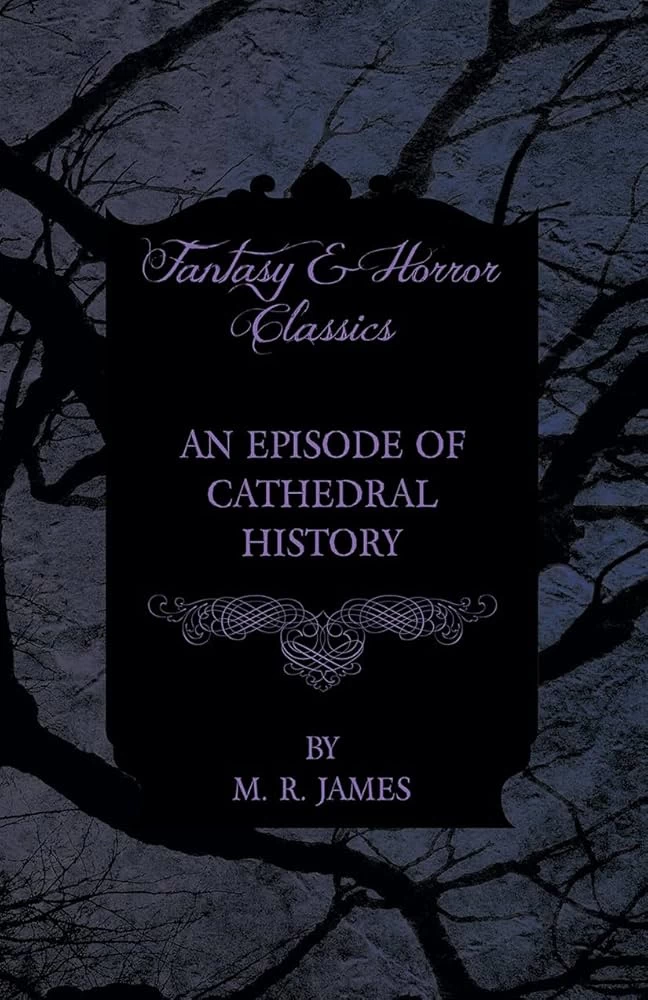“An Episode of Cathedral History” is a horror story by the English medievalist and author M. R. James (1862–1936), first published in the Cambridge Review in 1914 and included in his A Thin Ghost and Others Collection of five short stories by the English medievalist and author M. R. James, first published in 1919. (1919).[1]
Collection of five short stories by the English medievalist and author M. R. James, first published in 1919. (1919).[1]
The story concerns the discovery of a long-hidden tomb in the Cathedral of Southminster during renovation work, following which nearby residents begin to fall sick and die. It is told as a third-person narrative.
Synopsis
Mr Lake has been asked to examine and report on the archives of Southminster Cathedral, and as the task will take some time to complete is lodging with the verger, Mr Worby.
At about nine o’clock one evening, Worby has to go over to the cathedral, and invites Lake to accompany him to see what the cathedral looks like at night. Inside, Worby points out a plain-looking stone tomb with a large metal cross on its north side, the occupant of which is unrecorded, but which Worby says has a story attached to it, which he tells to Lake later that evening, by the comfort of the fire in his sitting room.
Some years earlier, in 1840, when Worby was a choirboy, a new dean had taken charge of the cathedral. A keen admirer of the Gothic Revival style of architecture, he ordered that the interior should be stripped of everything added after the medieval period, which included the pulpit. The oldest member of the cathedral chapter warned the dean not to disturb the pulpit, telling him that “you don’t know what mischief you may do”. But it was nevertheless removed, revealing a plain altar tomb, the occupant of which remains unknown. There was a gap two or three inches wide between two of the slabs comprising the side of the tomb.
Shortly after the tomb’s discovery, several of the older residents who lived near the cathedral died, and many others living nearby fell sick. The widow of a former verger frequently dreamt of a shadowy figure leaving the cathedral at night. Each night it went in a different direction and spent time in several houses. Just as dawn approached, the figure returned to the cathedral. At the end of the woman’s dream, the shadowy figure turned to face her, and she saw that it had red eyes.
The restoration of the cathedral excited much interest, and the visit of a celebrated antiquarian to write an account for the Society of Antiquaries. He was accompanied by his wife, who was to make a series of illustrative sketches. She seated herself on the altar tomb while making one of her drawings, and on finishing discovered that a piece of her skirt had been torn off, as if by a dog, but it was nowhere to be found.
Worby and his friend, another choirboy named Evans, overheard Palmer the mason shouting at one of his assistants, chastising him for not having filled in the gap in the tomb. The assistant said that he had filled in the gap with plaster, but that must have fallen out; the piece of plaster was found three feet away from the tomb.
On looking through the gap in the tomb, Evans said he could see something shiny. He rolled up some sheet music and pushed it through the gap several times, to no avail. Worby had the idea of whistling before shoving the sheet music into the tomb, and this time he heard something stirring inside; when he pulled out the sheet music, the end of the page had been torn off.
Repeated efforts were made to fill in the gap, but all were unsuccessful. One morning, Worby gathered from a remark made by his father at breakfast that something unusual was to happen at the cathedral after the following day’s morning service. So after that service Worby and Evans hid themselves high up in the cathedral, looking down at the tomb. The dean, Palmer the mason and Worby’s father, along with several other men, gathered around the tomb with crowbars, to prise apart the two slabs with the gap between them. The opening of the tomb was accompanied by a loud crashing sound, and the dean fell over, exclaiming “Good God!” After he was helped back to his feet, the tomb was found to contain only a piece of cloth and a torn piece of sheet music.
Later that day, Worby admitted to his father that he was in the cathedral when the tomb was opened. Worby’s father asked if he saw what knocked the dean over, which he did not. His father said that the dean was knocked down by something that looked like a man, except that it was covered in hair and had “two great eyes”.
One of the canons of the cathedral, Dr Lyall, subsequently paid for the metal cross now on the north side of the tomb, with the Latin inscription “IBI CUBAVIT LAMIA”, meaning “There lay the vampire”.
See also
- List of works by M. R. James
 List of the works written by M. R. James (1862–1936).
List of the works written by M. R. James (1862–1936).
External links
- Full text of “An Episode of Cathedral History” at Project Gutenberg
- Reading by Cornelius Garrett at YouTube

